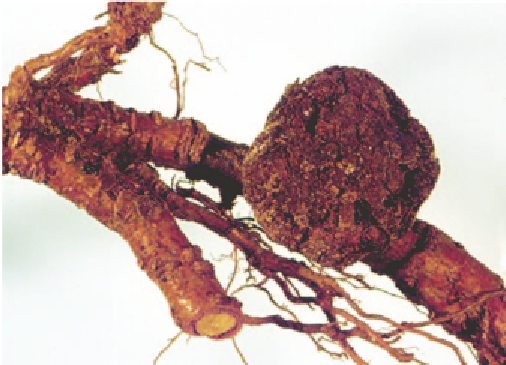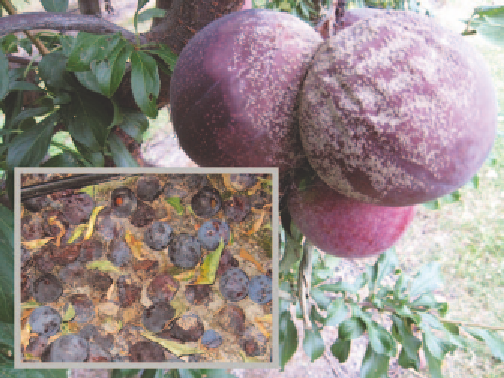Agriculture Reference
In-Depth Information
Prune infected fruit, leaves, twigs and mummies from
the orchard to reduce inoculum; this should be done as
a priority during thinning, harvest, at the end of the
growing season and during annual pruning of trees.
Ensure that all these infected materials are removed
from the orchard or completely broken down before
the new season starts.
Source of infection and spread
This disease is common in Australian orchards, except for
Western Australia. The bacteria survive in nursery and
orchard soils and are spread by water to the roots of young
seedlings.
•
Importance
The disease can cause significant losses in stone fruit trees
if not controlled during propagation.
Reduce humidity within the orchard by:
-
•
avoiding low-lying sites with poor air movement
and soil drainage
Management
A highly effective biocontrol agent (NoGall™) is available.
This agent is a selected strain of
Agrobacterium radiobacter
,
which prevents infection by the crown gall bacterium.
-
avoiding irrigation systems that wet the leaves
-
ensuring that the undergrowth at the base of the
windbreaks allows some gentle wind movement
-
shaping trees to allow good spray penetration
and rapid drying of the canopy.
Before germination, dip seed in the biocontrol agent.
•
Dip nursery tree roots in the biocontrol agent at the time
of planting.
•
CROWN GALL
■
Cause
The bacterium
Agrobacterium tumefaciens
.
Remove and dispose of affected trees well away from
the orchard.
•
Select a site with good drainage.
•
Avoid root damage.
•
Symptoms
Hard, woody, irregularly shaped galls up to 100 mm in
diameter, and with rough surfaces, form at the crown of
young seedlings. Smaller galls up to 40 mm in diameter
occasionally form on secondary roots. Galls sometimes
form above ground on young stems, and rarely on the
lower branches. A less common symptom is a proliferation
of the fine roots of young trees ('hairy root'). The disease
may develop soon after planting, reducing vigour and
leading to severe stunting or death. More frequently, the
disease takes many years to develop until galling of the
crown roots occurs and anchorage of the tree is affected.
Disinfect pruning and propagating equipment frequently.
•
FUNGI
BROWN ROT (OR BLOSSOM BLIGHT)
■
Cause
The fungi
Monilinia fructicola
and
M. laxa
.
Fig 17.9 A large root gall caused by crown gall bacteria.
Fig 17.10 Brown rot on plum. Inset: fruit litter is a source of inoculum.













